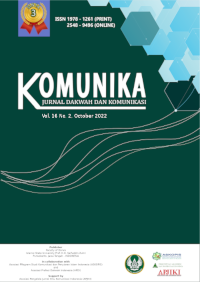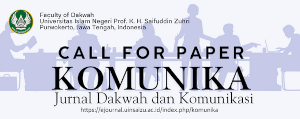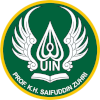The Patterns of Early Childhood Media Consumption in the Digital Television Era
DOI:
https://doi.org/10.24090/komunika.v16i2.6853Keywords:
media consumption, early childhood, digital televisionAbstract
This study aims to analyze consumption patterns of children's programs on digital media in Indonesia. The research uses a qualitative approach with the uses and gratification theory as a theoretical framework—collecting research data through in-depth interviews with respondents. The research respondents were ten informants aged at least 21 years with children ranging in age from 2 to 6 years. The respondents were interviewed in-depth to get answers regarding the pattern of watching children's entertainment media shows in their respective homes. The study results reveal that parents choose television and YouTube as entertainment media for their early childhood. Parents give these two media because YouTube has three elements: interactivity, demassification, and asynchronous, while television is considered a counterbalance to smartphone addiction in children. The media consumption patterns of each family are remarkably diverse but have identical motives. The primary reason parents provide children's entertainment. Digital television has not been popular as an entertainment media option for early childhood.Downloads
References
Abidin, 2019. Hubungan antara Tayangan K-Drama di Televisi dengan Perilaku pada Anak Remaja dalam Mengimitasi Korean Fashion. Jurnal Komunika, 3(1), 69. https://doi.org/10.24090/komunika.v13i1.2075
Aprilia, D., & Sufriani, S. (2017). Perilaku Menonton dengan Perkembangan anak usia prasekolah. Jurnal Ilmiah Mahasiswa Fakultas Keperawatan, 2(3), 3.
Astarini, N.,Hamid., S.I., Rustini, T.(2017). Studi Dampak Tayangan Televisi terhadap Perkembangan Perilaku Sosial Anak. Jurnal Cakrawala Dini, 8 (1), 9. https://doi.org/10.17509/cd.v8i1.10554
Databox.Katadata.co.id. 2020. Media Konvensional Menuju Senja Kala. https://databoks.katadata.co.id/datapublish/2021/02/01/media-konvensional-di-indonesia-menuju-senjakala
Databox.Katadata.co.id. 2022. Ada 204,7 juta pengguna internet awal 2022 https://databoks.katadata.co.id/datapublish/2022/03/23/ada-2047-juta-pengguna-internet-di-indonesia-awal-2022#:~:text=Jumlah%20Pengguna%20Internet%20di%20Indonesia%20(2018%2D2022*)&text=Menurut%20laporan%20We%20Are%20Social,tercatat%20sebanyak%20202%2C6%20juta.
KPI. 2021. Hasil Riset Indeks Kualitas Program Siaran Televisi Periode II Tahun 2021. Jakarta.
Noviana, I. (2007). Pola Menonton Televisi Pada Anak (Studi Kasns di SDN Johar Barn 1 Jakarta Pusat dan SD Islam Al Azhar, Kebayoran Baru, Jakarta Selatan). Sosio Konsepsia: Jurnal Penelitian dan Pengembangan Kesejahteraan Sosial, 12(3), 70-79.
Permana, Sapya., Aceng Abdullah., & Jimi Narotama. (2019). Budaya Menonton Televisi di Indonesia: Dari Terestrial Hingga Digital. ProTVF, 3 (1), 61-62. https://doi.org/10.24198/ptvf.v3i1.21220
Rahmadi, Dedi. (2020 November 10). Akses Anak ke TV dan Medsos Meningkat Saat Pandemi Covid-19. Merdeka.com. Diambil dari: https://www.merdeka.com/peristiwa/akses-anak-ke-tv-dan-medsos-meningkat-saat-pandemi-covid-19.html
Sangidun (2015). Pornografi dalam Serial Anime Anak (Analisis Semiotika dalam Serial Crayon Shin Chan). 9(1), 109. https://doi.org/10.24090/komunika.v9i1.833
Widyastuti.,Suryawinata,M. (2020). Bijak Memfasilitasi Gawai. Sidoarjo: Umsida Press.https://doi.org/10.21070/2020/978-623-6292-01-3
Wiresti. 2020. Aspek Perkembangan Anak: Urgensitas Ditinjau dalam Paradigma Psikologi Perkembangan Anak. Aulad: Journal on Early Childhood 3(1), 38-39. https://doi.org/10.31004/aulad.v3i1.53

Downloads
Published
Issue
Section
License
Copyright (c) 2022 Suci Lukitowati, Widha Anistya Suwarso, Dea Varanida

This work is licensed under a Creative Commons Attribution-ShareAlike 4.0 International License.
Authors who publish with this journal agree to the following terms:
- Authors retain copyright and grant the journal right of first publication with the work simultaneously licensed under a Creative Commons Attribution-ShareAlike 4.0 International License that allows others to share the work with an acknowledgement of the work's authorship and initial publication in this journal.
- Authors are able to enter into separate, additional contractual arrangements for the non-exclusive distribution of the journal's published version of the work (e.g., post it to an institutional repository or publish it in a book), with an acknowledgement of its initial publication in this journal.
- Authors are permitted and encouraged to post their work online (e.g., in institutional repositories or on their website) prior to and during the submission process, as it can lead to productive exchanges, as well as earlier and greater citation of published work (See The Effect of Open Access).




























